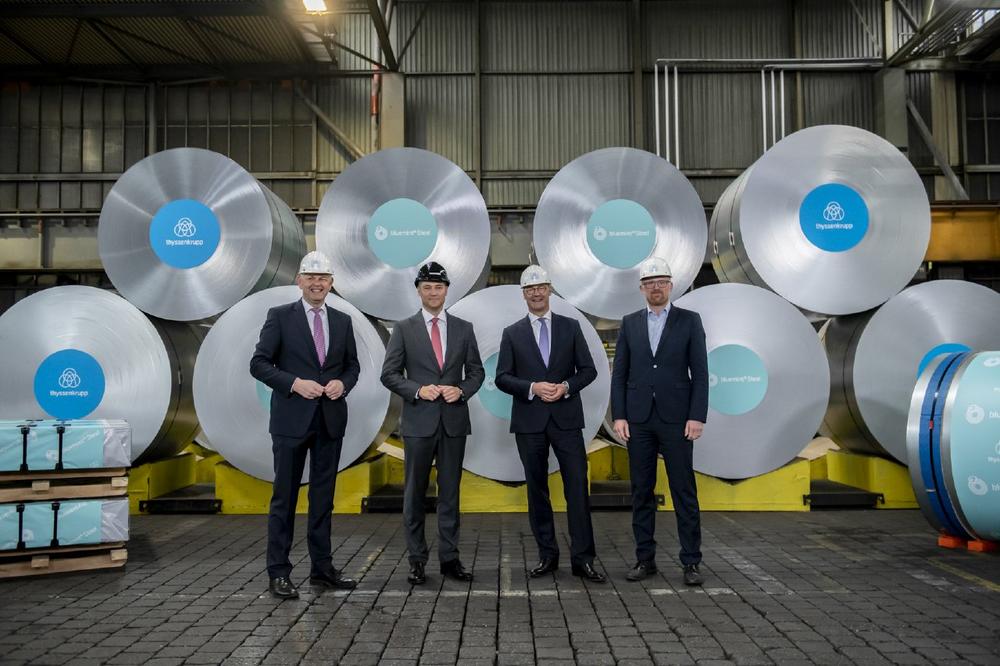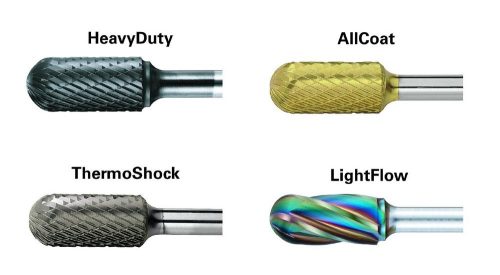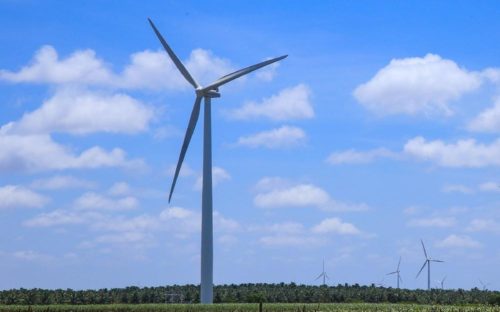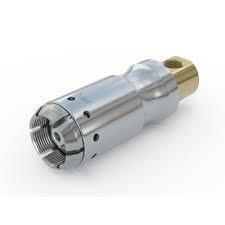
bluemint® Steel: thyssenkrupp Steel launches steel with an allocated low CO2 intensity
- Up to 70 per cent lower allocated CO2 intensity with newly introduced bluemint® Steel
- Allocation approach for reduction of carbon dioxide emissions per tonne of bluemint® pure steel at the Duisburg site with independent assurance by the international certification body DNV
- Separate certificate from TÜV Süd validates scrap recycling via blast furnace allowing for a considerable reduction in carbon dioxide emissions
- Premium bathroom solution provider Kaldewei as first bluemint® pure client
Duisburg, October 6th. thyssenkrupp Steel has successfully attained a significant milestone along the green transformation path towards climate-neutral steel. Today, the first batches were delivered under the new brand name bluemint® Steel. The first customer to be supplied with flat steel products of the bluemint® family is the Ahlen-based premium bathroom builder Kaldewei. The approach to reducing the CO2 emissions at the blast furnace, which has been independently assured by the international certification body DNV, allows for the allocation of the carbon emission savings to a specific quantity of the product bluemint® pure. The carbon emission intensity per tonne of steel produced is thus reduced by 70 per cent. The benefits that can be achieved using this approach were also confirmed by Wuppertal Institute for Climate, Environment and Energy – thyssenkrupp Steel’s advisor to the project.
Calculation method for emission control in alignment with international standards
bluemint® pure has all direct emissions from its production at the Duisburg site neutralized by savings in the production process– the emissions of the so-called upstream chain (Scope 3) are retained. These include all emissions that occur during the production and transportation of the raw materials. In this way, the emission intensity per tonne is reduced by 1.5 tonnes to 0.6 tonnes of CO2 per tonne product, which corresponds to an overall reduction of 70 per cent. This positive effect is achieved through the use of already reduced iron (HBI). This allows for less coal consumption in the reduction process at the blast furnace. This achieves a verifiable reduction of emissions. Priti Hoffmann, Sustainability lead, Benelux at DNV: “DNV reviewed the methodology developed by thyssenkrupp Steel and the data from an initial trial period of HBI use in a blast furnace at their Duisburg plant. I am pleased that DNV Business Assurance has played an essential role for thyssenkrupp Steel in this landmark launch of bluemint® pure steel products. bluemint® pure steel certificates, for steel products with a reduced CO2 intensity, are based on CO2 savings in the steel production process which are achieved by changing input materials in the blast furnace. These savings are then allocated to a quantity of steel products, according to a methodology, which has been assured by DNV. The methodology for calculating product-related CO2 savings is in accordance with the internationally recognised Greenhouse Gas Protocol for Product Life Cycle Accounting and Reporting Standard.”
The fact that carbon savings allocation approaches can support the decarbonisation of the steel sector is acknowledged by the Wuppertal Institute for Climate, Environment and Energy. Prof. Dr. Stefan Lechtenböhmer points out: "We have examined various options with thyssenkrupp Steel 2020 as to how CO2 savings can already be achieved in the short term within the framework of conventional blast furnace technology. The way to distribute the CO2 reductions achieved in real terms via a balance-sheet approach calculated on the product is feasible and makes sense. What is important here is that these are additional climate protection measures and that they are part of a comprehensive decarbonisation strategy for steel production.”
Marketing launch for steel with an allocated low CO2 intensity
The launch of the bluemint® product family also marks the start of active marketing measures for products with an allocated low CO2 intensity. Bernhard Osburg, CEO of thyssenkrupp Steel, explains: ”It is important that we can provide our customers with products that contribute to real and measurable carbon dioxide reduction as quickly as can be. This is where we start. We are very happy to be supplying our products to Kaldewei, a company that is particularly committed to the idea of sustainability. We will now gradually expand the commercialization of our CO2-reduced bluemint® Steel range and have already commenced negotiations with a number of additional customers.”
Franz Kaldewei: “bluemint® pure offers us the certainty of already being able to use the highest quality steel at a low carbon intensity for the production of our steel enamel bathroom solutions. This is an important step towards achieving our climate targets. With bluemint®steel from thyssenkrupp, we are clearing a major hurdle on the way to Kaldewei’s climate-neutral orientation.”
TÜV Süd approves use of scrap in blast furnaces
A second, separate approach towards a CO2-reduced steel production has been taken by thyssenkrupp Steel by obtaining certification from TÜV Süd in accordance with the VERIsteel procedure. This involves the use of scrap in the blast furnace process. This technological change will once again result in an absolute reduction of CO2 emissions at the Duisburg site. This is also achieved through a reduced coal consumption, since correspondingly less coal is needed for melting the scrap in the blast furnace. For each tonne of recycled product, a reduction in emission intensity from 2.1 tonnes to 0.75 tonnes of CO2 is achieved and accounted for on the balance sheet.
Systematic implementation of the transformation strategy
The bluemint pure steel now being delivered are part of the comprehensive transformation strategy at thyssenkrupp Steel. The crucial milestone in the transformation of Europe’s largest integrated steel mill towards climate neutrality will be the replacement of the conventional blast furnaces with hydrogen-fuelled direct reduction plants. The commissioning of the first large-scale plant including a melter is planned for 2025.
In the run-up to this technological leap, all possibilities are being exploited to noticeably reduce the CO2 emissions during production already with the existing blast-furnace-based technology. The use of HBI or scrap as carbon-reducing feedstock is the first step. In the future, thyssenkrupp Steel will also expand the use of hydrogen in the blast furnace and thus further increase the production of environmentally friendly steel. The world’s first trials on the use of hydrogen started in Duisburg back in 2019 and have meanwhile been successfully accomplished. Christoph Dammermann, State Secretary at the Ministry of Economic Affairs, Innovation, Digitalization and Energy, points out: “The Ruhr is predestined to become a model region for decarbonization. thyssenkrupp is sending a clear signal here with the first CO2-reduced steel produced in Duisburg. The NRW state government is accompanying the transformation, also here at the site, with practical funding projects, such as the world’s first hydrogen trials in the blast furnace. We know that the leverage for CO2 reduction is particularly great in the steel industry. Thus, it is particularly important to harness this potential for efficient climate protection at the industrial level.”
thyssenkrupp Steel Europe AG
Kaiser-Wilhelm-Str. 100
47166 Duisburg
Telefon: +49 (203) 52-0
Telefax: +49 (203) 52-25102
http://www.thyssenkrupp-steel-europe.com
SE/COM
Telefon: +49 (203) 52-25159
E-Mail: mark.stagge@thyssenkrupp.com
![]()




